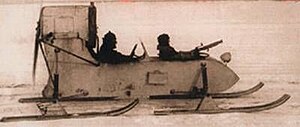Aerosledge

An Aerosledge (Russian: aэросани, "aerosani") is a propeller-driven sledge, sleigh or toboggan which slides on runners or skis. Aerosleds are used for communications, mail deliveries, medical aid, emergency recovery, and patrolling borders in countries such as northern Russia, as well as for recreation. Aerosani were used by the Soviet Red Army during the Winter War and World War II.
The first aerosledges may have been built in 1903–05 by Sergei Nezhdanovsky.[citation needed] In 1909–10, young Igor Sikorsky designed and tested an aerosledge, before going on to build multi-engine airplanes and helicopters. They were light plywood vehicles on skis, powered by used vintage aircraft engines and propellers.[1]
Military usage
[edit]

Military use of the aerosani goes back to at least the 1910s. During World War I, aerosani were used for reconnaissance, communicating, and light raiding in northern areas. During the 1939–40 Winter War against Finland some were equipped with a machine gun ring mount on the roof.[2] They could carry four or five men and tow four more on skis. The aerosani were initially used for transport, liaison, and medical evacuation in deep snow, mostly in open country and on frozen lakes and rivers because of their poor hill-climbing ability and limited maneuverability on winding forest roads.
During World War II aerosani were used for reconnaissance, communication, and light raiding in northern areas thanks to their high mobility (25–35 km/h) in deep snow, where many vehicles could not move at all.[3] Responsibility for aerosani was transferred to the Soviet Armoured Forces (GABTU) and orders were submitted for design and fabrication of lightly armoured versions, protected by ten millimetres of steel plate on the front. They were organized into transport or combat battalions of 45 vehicles, in three companies, often employed in cooperation with ski infantry. Troops were usually carried or towed by transport aerosani, while fire support was provided by the heavier machine gun-armed, armoured models. Aerosani were not used for direct assault because of their vulnerability to explosives such as mortar rounds.
The ANT-I through ANT-V were a successful series of aerosani of the 1920s and ’30s, designed by aircraft engineer Andrei Tupolev. A claim exists that in 1924 the Soviets obtained plans and specifications for 'air sleighs' from Chester B. Wing, an aviator, automobile dealer and former mayor of St. Ignace, Michigan, U.S.A. He had built practical aerosleds to aid transportation across the ice between St. Ignace and Mackinac Island, and for use by fishermen. The Spring 1943 issue of the magazine Science and Mechanics states that "from his aerosleds the Russians developed their present battle sled." The claim though has to be viewed in the context of a pre-World War I picture of an Igor Sikorsky machine in Kiev.
The first military aerosani used in Finland, the KM-5 and OSGA-6 (later called NKL-6), were initially built at the Narkomles Factory in Moscow. During World War II, improved NKL-16/41 and NKL-16/42 models were built, and production started at the ZiS and GAZ car factories, and at smaller industries such as the Stalingrad Bekietovskiy Wood Works. In 1941 the armoured NKL-26, designed by M. Andreyev, started production at Narkomles. The following year, Gorki Narkorechflota developed the smaller, unarmoured GAZ-98, or RF-8, powered by a GAZ-M1 truck engine and a durable metal propeller. There was also an ASD-400 heavy assault sled used in World War II.
See also
[edit]- Airboat
- Hydrocopter
- Ekranoplan
- Armoured fighting vehicle
- KRISTI snowcat
- Battle sled
- Multi-passenger snowmobiles
References
[edit]- ^ "The Propeller-Driven Sleigh". SelfSite. July 26, 2005. Archived from the original on July 10, 2011. Retrieved 2008-09-11.
- ^ Chris Bellamy (2008). Absolute War: Soviet Russia in the Second World War. Knopf Doubleday Publishing Group. ISBN 9780307481139. Retrieved 5 April 2018.
- ^ Nigel Thomas (2011). World War II Soviet Armed Forces (2): 1942–43. Bloomsbury Publishing. ISBN 9781849088282. Retrieved 5 April 2018.
Bibliography
[edit]- Zaloga, Steven J., James Grandsen (1984). Soviet Tanks and Combat Vehicles of World War Two, pp. 185–87, London: Arms and Armour Press. ISBN 0-85368-606-8.
- Science and Mechanics, Spring 1943, p. 49.
External links
[edit]- propeller-driven sleds at Lonesentry.com
- The Propeller-Driven Sleigh
- N007 Tupolev, aerosled with ground effect
- At the Russian Battlefield:
- Boyevyye aerosani 'Combat aerosani' at Brone-Sayt (Russian language)
- Aerosani-amfibiya AS-2, a modern amphibious recreational vehicle from aircraft manufacturer Tupolev (Russian language)
- Aerosani in WWII Article in Poligon magazine, 1'2002 (at Otvaga site).